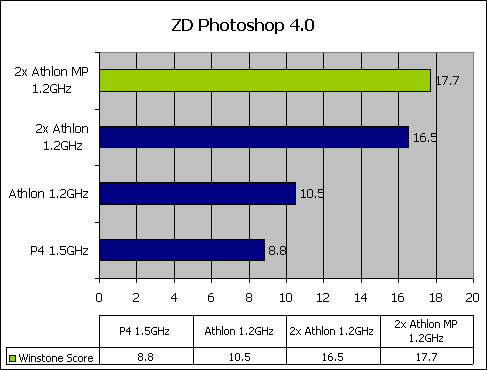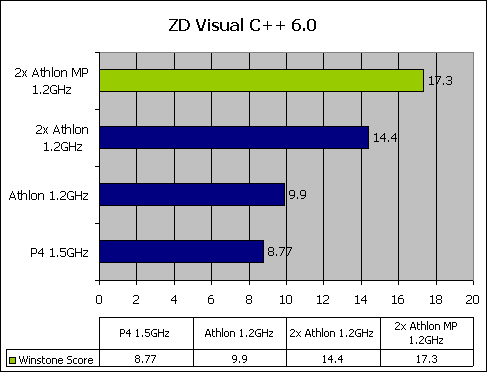 |
|
|
|
In the Forums... |
Posted: June 5th, 2001 Written by: Tuan "Solace" Nguyen Benchmarks (cont.) Photoshop 4.0 Photoshop, being the de-facto standard in graphics creation, is also part of the ZD bench package. Since this is Photoshop 4 and not the latest, its not quite parallel friendly as 6 is. Still, the ALU performance of the Athlon MP should come into fairly good use in this test.  Here we see the 2x Athlon MP system wipe the floor clean with its powerful ALU two hit combo. Taking the lead by more than 53% above the Pentium 4 system, we see this is indeed the platform choice for graphics professionals. Considering that two regular Athlon system performs almost as well as the two Athlon MP system is a strong indication of how efficient and speedy the 760MP chipset is. Visual C++ 6.0 You maybe wondering why bother testing compiler time with a dual system since compiling a program isnít a highly parallel task at all. Thatís true. However, this Visual C++ is testing the compilation time of two separate programs. Two sources are being compiled at the same time and thus, should take advantage of the second processor.  From the graph we see that our hypothesis is true. While the Athlon MP system takes the lead the dual Athlon configuration does quite well here too except that it falls behind a bit from the lack of MP enhanced features. Performance is nearly doubled when going from a single Athlon system to a dual Athlon MP system. What does the Ziff Davis DPI test signify? It says that a dual Athlon system is a professionalís dream system. For those professionals seeking ultimate performance for CAD/graphics/programming work, saying no to a dual Athlon MP system is a hard choice. Corporate buyers will also benefit from the cost savings offered by going with AMD instead of Intel. A 760MP/Athlon MP system is a very attractive investment for the corporate buyers indeed. |
||
|
| |||
|---|---|---|---|